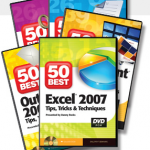I use Keyboard Shortcuts in Excel everyday. However, the one that I count on the most; The one that has saved me from near disaster on multiple occasions is:
Ctrl + Z – The UNDO Command.
Ctrl + Z can Undo my last 16 actions (one at-a-time.) In Excel 2007, you can Undo up to 100 of your last actions!
Watch this short Excel Training Video as I demonstrate how to take advantage of the Ctrl + Z Shortcut.
Here are the steps to follow in this lesson:
- Type an entry or apply formatting to a cell or range of cells.
- Hold down the “Ctrl” Key while you press the “Z” key. Excel will Undo your last action.
- To Restore the Action that you just UNDID, use the “Ctrl + Y+ Keyboard Shortcut.
- You can Undo your last 16 actions in Excel 2003. Use the drop-down menu next to the UNDO Command Button on the Standard Toolbar.
- Follow a similar procedure to RESTORE up to your last 16 actions in Excel 2003 with the drop-down menu next to the Restore Command button on the Standard Toolbar.
- In Excel 2007, you can UNDO and RESTORE up to your last 100 Actions!
Are you looking for Excel Video Training for a specific topic? Search my Index of Excel Video Topics.
Related Videos:
NEW! Now you can practice your Excel Skills – Download the Excel Workbooks that I use in my video lessons















